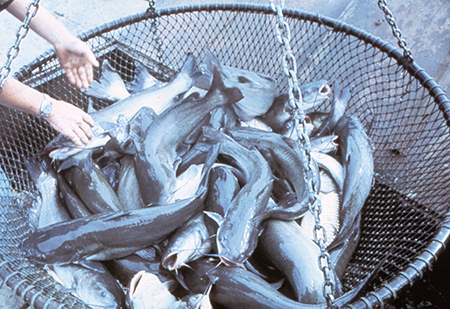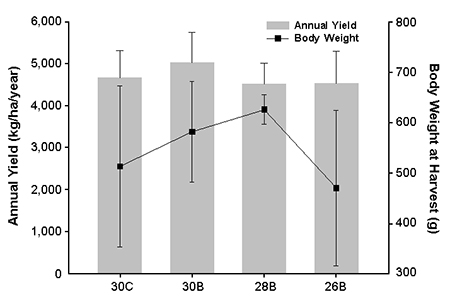Protein levels best at between 24 and 26 percent

Protein is the most expensive component of channel catfish feeds and a primary source of nitrogenous waste in production ponds. Reducing the protein content of catfish feed to the minimum needed to promote acceptable growth can provide economic and environmental benefits in the form of decreased production cost and improved water quality. However, protein reductions must be made carefully to ensure that dietary amino acid requirements are satisfied.
Previous research
Pond production trials at the Aquaculture Research Station of the Louisiana State University Agricultural Center in Baton Rouge, Louisiana, USA have demonstrated that weight gains and production yields of channel catfish fed a 26 percent-protein feed did not differ significantly from gains and yields of fish fed 28 to 30 percent levels of protein, when the amino acid composition of the feed was strictly controlled.
Amino acid balance
In these experiments, protein levels were lowered by reducing the quantity of dietary nonessential amino acids (NEAA) in the feed while maintaining essential amino acids (EAA) at levels sufficient to meet dietary requirements. Unlike typical catfish feeds, the feeds used in these trials were formulated to possess an amino acid balance similar to that of the channel catfish body.
Feed formulation
Four feeds were formulated with practical ingredients (soybean meal, corn, wheat middlings, rice bran, alfalfa meal, meat and bone meal, blood meal, and cottonseed meal) to provide a series of decreasing protein levels.
Protein levels were reduced by progressively lowering NEAA concentrations. The total NEAA content of the feed with the lowest (26 percent) amount of protein was about 30 percent below that of the feed with the most (30 percent) protein. Excesses of all amino acids were minimized and ratios of each NEAA relative to lysine (usually the most limiting amino acid in catfish feeds) were matched to those in catfish tissues.
The finished feeds were identified as:
- 30C, a control formula with 30 percent crude protein that met minimum dietary requirements for lysine and methionine, but with no adjustment of other EAA or NEAA.
- 30B, a 30 percent protein formula that met minimum dietary requirements for all EAA and contained levels of NEAA similar to those in the bodies of channel catfish.
- 28B, a 28 percent protein formula that met minimum dietary requirements for all EAA but with NEAA levels about 10 to 20 percent below those in catfish tissues.
- 26B, a 26 percent protein formula that met minimum dietary requirements for all EAA but with NEAA levels about 20 to 30 percent below those in catfish tissues.
The feeds were custom-manufactured as extruded, floating pellets. Levels of protein, EAA, and NEAA in the finished feeds were confirmed by analysis. Energy-to-protein ratios of 37.7 kJ digestible energy per gram protein were equal in all treatments.
Experimental setup
Juvenile channel catfish of 8 to 10 cm length were stocked into 16, 0.08-ha ponds at a density of 25,000 fish per hectare for a two-year production trial. The ponds were managed as multiple-cropped production systems with periodic top harvests and subsequent restocking.
Each feed was assigned to four ponds of fish. Fish were fed once daily during the growing season to apparent satiation at rates of 84 to 101 kilograms per hectare per day. Ponds were top harvested and restocked in the fall of the first year and in the spring and fall of the second. In the spring of the third year, the ponds were batch harvested and drained.
Results

There were no significant differences (P > 0.05) in the weight of fish stocked (pooled mean: 191 kilograms per treatment) or weight of fish harvested (pooled mean: 759 kilograms per treatment) among treatment groups during the two-year period. The amount of feed provided (pooled mean: 2,371 kilograms per treatment) and feed-conversion ratios (pooled mean: 3.2) were also not significantly different among treatments.
Annual per-hectare yields and individual fish weights at harvest also did not differ significantly (Fig. 1). Dressed yields (pooled mean: 59 percent) were not significantly different among treatments. However, fish fed 26 percent-protein feed had lower levels of visceral fat (2.2 percent) than fish fed 30C (2.5 percent) or 30B (2.7 percent).
Conclusion
Results indicated that a 26 percent protein feed can be suitable for long-term production of channel catfish in top-harvested, multiple-cropped ponds. Moreover, results of a recent laboratory experiment and pond production trial at Louisiana State University’s Aquaculture Research Station suggested that feeds with protein levels as low as 24 percent may be suitable for catfish if amino acid composition is properly balanced. Further research is in progress to determine the practical lower limit of crude protein in channel catfish feeds.
(Editor’s Note: This article was originally published in the August 2002 print edition of the Global Aquaculture Advocate.)
Now that you've finished reading the article ...
… we hope you’ll consider supporting our mission to document the evolution of the global aquaculture industry and share our vast network of contributors’ expansive knowledge every week.
By becoming a Global Seafood Alliance member, you’re ensuring that all of the pre-competitive work we do through member benefits, resources and events can continue. Individual membership costs just $50 a year. GSA individual and corporate members receive complimentary access to a series of GOAL virtual events beginning in April. Join now.
Not a GSA member? Join us.
Authors
-
Robert C. Reigh, Ph.D.
Louisiana State University Agricultural Center
Aquaculture Research Station
2410 Ben Hur Road
Baton Rouge, Louisiana 70820-6103 USA[117,100,101,46,117,115,108,46,114,116,99,103,97,64,104,103,105,101,114,114]
-
Millie B. Williams
Louisiana State University Agricultural Center
Aquaculture Research Station
2410 Ben Hur Road
Baton Rouge, Louisiana 70820-6103 USA -
Weibing Yan, Ph.D.
Louisiana State University Agricultural Center
Aquaculture Research Station
2410 Ben Hur Road
Baton Rouge, Louisiana 70820-6103 USA
Related Posts

Health & Welfare
Amino acid supplementation reduces protein levels in pangasius diets
Trials show that supplementation with amino acids could reduce protein levels from a typical 28 percent to 23 percent in pangasius diets.

Health & Welfare
Brazilian researchers examine amino acids in Nile tilapia diets
Determining dietary requirements for tilapia requires precise formulation. Individual amino acids must be considered to establish well-balanced diets.

Intelligence
Adding flavor complexity to farmed barramundi
Organoleptic attributes such as flavor and aroma are among the most important factors that influence consumer acceptability and demand for fish products. Consumers have identified farmed fish as less complex and lacking “sealike” or “sea-fresh” flavors and aromas.

Health & Welfare
Dietary threonine factor in tilapia fillet yield
In a commercial field trial, Nile tilapia were distributed in net cages and fed diets containing increasing threonine:lysine ratios.


